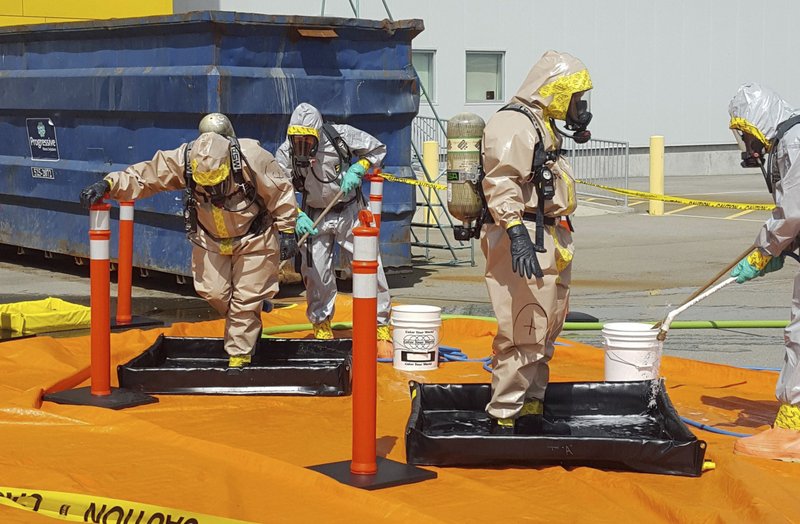BEIJING -- U.S. assertions that China is the top source of the synthetic opioids that have killed thousands of drug users in the U.S. and Canada are unsubstantiated, Chinese officials said.
Both the U.S. Drug Enforcement Administration and the White House Office of National Drug Control Policy point to China as North America's main source of fentanyl, related drugs and the chemicals used to make them.
Such statements "lack the support of sufficient numbers of actual, confirmed cases," China's National Narcotics Control Commission told the DEA's Beijing office in a fax dated Friday.
In its letter, which the commission also sent to The Associated Press, Chinese officials urged the U.S. to provide more evidence about China's role as a source country.
DEA officials said their casework and investigations consistently lead back to China.
They said DEA data also show that when China regulates synthetic drugs, U.S. seizures plunge.
"China is not the only source of the problem, but they are the dominant source for fentanyls along with precursor chemicals and pill presses that are being exported from China to the U.S., Canada and Mexico," said Russell Baer, a DEA special agent in Washington.
Beijing is concerned enough about international perceptions of China's role in the opioid trade that after the AP published investigations highlighting the accessibility of fentanyls online from Chinese suppliers, the narcotics commission invited a team of AP journalists to discuss the issue at the Ministry of Public Security, a leafy complex just off Tiananmen Square at the historic and political heart of Beijing.
The global epidemic of opioid abuse has killed more than 300,000 Americans since 2000.
The presence of fentanyl, a prescription painkiller up to 50 times stronger than heroin, and related compounds in the U.S. drug supply began to rise in 2013, after dealers learned they could multiply profits by cutting the potent chemicals into heroin, cocaine and counterfeit prescription pills.
Even as the U.S. Congress considers legislation to punish opioid source countries, no government agency has produced comprehensive data on seizures of fentanyl-related substances by country of origin.
The national database on drug seizures overseen by the DEA does not require reporting by source country and may not accurately reflect seizures of all fentanyl-related compounds. Baer said it didn't even have a "fentanyl" category until about two years ago. It also takes time for chemists to identify seized drugs, which means fentanyl-related samples may get incorrectly logged as other drugs.
The White House Office of National Drug Control Policy declined to comment.
U.S. Customs and Border Protection said it had data by country of origin only for 2015, when nearly two-thirds of the 134 pounds of fentanyl seized came from Mexico. The rest came from China.
DEA officials say Mexican cartels are key bulk suppliers of fentanyl to the U.S., but portray Mexico as a transshipment point.
Mexican officials, speaking on condition of anonymity because they were not authorized to be quoted, said fentanyl and its precursors were coming from China.
Only two labs trying to produce fentanyl from scratch have been located in Mexico in recent years, with others apparently taking simpler steps to turn precursors into fentanyl, the officials said.
Mexican authorities did not immediately respond to requests for seizure data by country of origin.
DEA officials say there is plenty of anecdotal evidence that China plays a key role in the fentanyls trade, and despite disagreements, Chinese authorities have been proactive in trying to stop fentanyl manufacture and export.
Chinese companies offering to export synthetic opioids are easy to find, the AP found in investigations published in October and November.
China's narcotics commission said it was scrutinizing 12 opioid vendors that the AP identified, along with others that advertise fentanyl analogs.
In some cases, China has been faster and more comprehensive in enacting changes to its drug control laws than much of the rest of the world.
Beijing already regulates fentanyl and 18 related compounds and is considering designating four more: carfentanil, furanyl fentanyl, acryl fentanyl and valeryl fentanyl, the narcotics commission said.
In the meantime, the commission said, it warned Chinese vendors and websites that carfentanil and other analogs are harmful and should not be sold.
The resulting ripple of anxiety prompted some companies to recommend alternative opioids, like U-47700, the AP found in conversations with a dozen vendors.
"Friend, fent is illegal in China," wrote one, referring to fentanyl. "It is dangerous for us."
Information for this article was contributed by Mark Stevenson, Desmond Butler and Fu Ting of The Associated Press.
A Section on 12/20/2016
